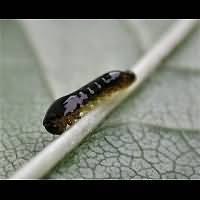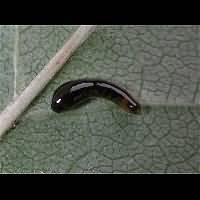Pear Slug Caliroa cerasi
Many adult sawflies are short-lived and unknown. Adult Pear Slugs for instance are dull blackish and some 5mm long. They are very similar to flies, but actually do have two pairs of wings. They are not often seen and still less frequently noticed. The larvae are well known and sometimes do damage to fruit trees. They are a transparent kind of green and shaped like a small slug. The legs give them away though: slugs do not have legs at all. To look like a slug even more, the larvae produce a shiny, black substance in which they cover themselves. Mimicry now is perfect: even many humans seeing them think of slugs, hence their name.
The Pear Slug is double brooded in most of its area. The females saw a little cut in the underside of a leaf. In this cut a bunch of eggs is deposited. The eggs hatch after some three to four weeks. The small larvae move to the upperside of the leaf, where they commence eating it. Only the upper skin and the contents of the leaf are eaten. The lower skin and the main veins are kept intact. Affected leaves are extremely thin and lots of light comes through them. It looks like they are lacy. This is typical for sawfly or leaf mining insects infestations. The affected leaves soon turn brown and then drop off. The larvae need one month only to become fully grown. They drop to the ground and bury themselves into the soil, usually one or two inches, and pupate. The second generation overwinters as a pupa before emerging in early spring. Despite the name, Pear Slugs are frequently found on cherries as well.
With Pears and Cherries the Pear Slug has been transported all over the world. It may be found in Europe, Asia, Japan, Northern America, Southern America and New Zealand. The damage by the first generation is small and doesn't lead to trouble. It is the second brood (September in the northern hemisphere) that does most damage. Some trees are completely defoliated and will loose their fruit prematurely. Yet, as long as the number of larvae is small there is no reason to kill them. Besides there are very effective chemical pesticides. Most damage is done in alternative and biological agriculture, where no chemicals are used.
Many adult sawflies are short-lived and unknown. Adult Pear Slugs for instance are dull blackish and some 5mm long. They are very similar to flies, but actually do have two pairs of wings. They are not often seen and still less frequently noticed. The larvae are well known and sometimes do damage to fruit trees. They are a transparent kind of green and shaped like a small slug. The legs give them away though: slugs do not have legs at all. To look like a slug even more, the larvae produce a shiny, black substance in which they cover themselves. Mimicry now is perfect: even many humans seeing them think of slugs, hence their name.
The Pear Slug is double brooded in most of its area. The females saw a little cut in the underside of a leaf. In this cut a bunch of eggs is deposited. The eggs hatch after some three to four weeks. The small larvae move to the upperside of the leaf, where they commence eating it. Only the upper skin and the contents of the leaf are eaten. The lower skin and the main veins are kept intact. Affected leaves are extremely thin and lots of light comes through them. It looks like they are lacy. This is typical for sawfly or leaf mining insects infestations. The affected leaves soon turn brown and then drop off. The larvae need one month only to become fully grown. They drop to the ground and bury themselves into the soil, usually one or two inches, and pupate. The second generation overwinters as a pupa before emerging in early spring. Despite the name, Pear Slugs are frequently found on cherries as well.
With Pears and Cherries the Pear Slug has been transported all over the world. It may be found in Europe, Asia, Japan, Northern America, Southern America and New Zealand. The damage by the first generation is small and doesn't lead to trouble. It is the second brood (September in the northern hemisphere) that does most damage. Some trees are completely defoliated and will loose their fruit prematurely. Yet, as long as the number of larvae is small there is no reason to kill them. Besides there are very effective chemical pesticides. Most damage is done in alternative and biological agriculture, where no chemicals are used.





